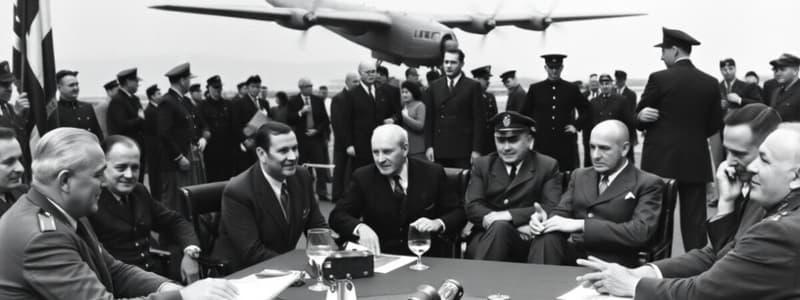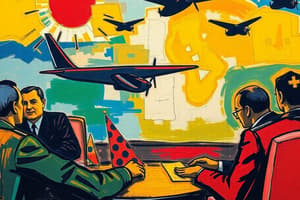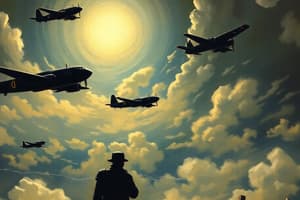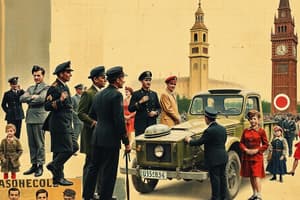Podcast
Questions and Answers
Prior to the Casablanca Conference, the Allies had never engaged in any bombing missions over Germany.
Prior to the Casablanca Conference, the Allies had never engaged in any bombing missions over Germany.
False (B)
General Bernard Montgomery, along with General Dwight D. Eisenhower, was in charge of the Allied forces during the invasion of Sicily.
General Bernard Montgomery, along with General Dwight D. Eisenhower, was in charge of the Allied forces during the invasion of Sicily.
False (B)
Due to the immense damage inflicted on aircraft factories by Allied bombing, Germany's air force found it impossible to replace its combat losses.
Due to the immense damage inflicted on aircraft factories by Allied bombing, Germany's air force found it impossible to replace its combat losses.
True (A)
General Montgomery's British forces executed daring end-runs around German positions in western Sicily, while Patton attacked from the south.
General Montgomery's British forces executed daring end-runs around German positions in western Sicily, while Patton attacked from the south.
Italy's surrender announcement on September 8, 1943, led to an immediate and unopposed Allied takeover of the entire Italian peninsula.
Italy's surrender announcement on September 8, 1943, led to an immediate and unopposed Allied takeover of the entire Italian peninsula.
Following Italy's surrender, Hitler strategically decided to withdraw German forces entirely from Italy, focusing on other fronts.
Following Italy's surrender, Hitler strategically decided to withdraw German forces entirely from Italy, focusing on other fronts.
What was the strategic objective behind the Allied landing at Anzio?
What was the strategic objective behind the Allied landing at Anzio?
What was the primary agreement reached between Stalin, Roosevelt, and Churchill at the Tehran Conference regarding Germany after the war?
What was the primary agreement reached between Stalin, Roosevelt, and Churchill at the Tehran Conference regarding Germany after the war?
What commitment did Stalin make at the Tehran Conference concerning the war in the Pacific?
What commitment did Stalin make at the Tehran Conference concerning the war in the Pacific?
What primary goal did the Allied forces set for the strategic bombing campaign against Germany, as agreed upon at the Casablanca Conference?
What primary goal did the Allied forces set for the strategic bombing campaign against Germany, as agreed upon at the Casablanca Conference?
What long-term strategic advantage did the Allied bombing campaign ultimately provide during the later stages of the war?
What long-term strategic advantage did the Allied bombing campaign ultimately provide during the later stages of the war?
Despite the Allies' strategic bombing campaign, which of the following outcomes was NOT achieved?
Despite the Allies' strategic bombing campaign, which of the following outcomes was NOT achieved?
How did the Allied forces' strategic approach to the invasion of Sicily reflect a coordinated command structure?
How did the Allied forces' strategic approach to the invasion of Sicily reflect a coordinated command structure?
What was the primary purpose of the DUKW during the Sicily invasion?
What was the primary purpose of the DUKW during the Sicily invasion?
What critical event occurred within the Italian government as a direct consequence of the Allied attack on Sicily?
What critical event occurred within the Italian government as a direct consequence of the Allied attack on Sicily?
Following Italy's surrender announcement, what immediate action did German forces undertake?
Following Italy's surrender announcement, what immediate action did German forces undertake?
What was a key geographical feature of the terrain near Cassino that posed a challenge during the Italian campaign?
What was a key geographical feature of the terrain near Cassino that posed a challenge during the Italian campaign?
What strategic objective did Hitler prioritize after Italy's surrender, influencing his decision to act swiftly?
What strategic objective did Hitler prioritize after Italy's surrender, influencing his decision to act swiftly?
In what direction did Patton's troops advance after securing western Sicily?
In what direction did Patton's troops advance after securing western Sicily?
What was the immediate consequence of the Italian government's public announcement of surrender on September 8, 1943?
What was the immediate consequence of the Italian government's public announcement of surrender on September 8, 1943?
Flashcards
Casablanca Conference
Casablanca Conference
A meeting in January 1943 where Roosevelt and Churchill agreed to increase the bombing of Germany and attack the Axis in Sicily.
Allied Bombing Campaign Goal
Allied Bombing Campaign Goal
The Allied goal was to systematically destroy Germany's military, industrial, and economic systems to weaken morale.
Strategic Bombing
Strategic Bombing
Between January 1943 and May 1945, the Allies dropped approximately 53,000 tons of explosives on Germany monthly.
Effects of Bombing Germany
Effects of Bombing Germany
Signup and view all the flashcards
Dwight D. Eisenhower
Dwight D. Eisenhower
Signup and view all the flashcards
DUKW
DUKW
Signup and view all the flashcards
July 10, 1943
July 10, 1943
Signup and view all the flashcards
General Patton
General Patton
Signup and view all the flashcards
King Victor Emmanuel
King Victor Emmanuel
Signup and view all the flashcards
September 8, 1943
September 8, 1943
Signup and view all the flashcards
German Troops
German Troops
Signup and view all the flashcards
Salerno
Salerno
Signup and view all the flashcards
Cassino
Cassino
Signup and view all the flashcards
Sicily Invasion Impact
Sicily Invasion Impact
Signup and view all the flashcards
July 25, 1943
July 25, 1943
Signup and view all the flashcards
Anzio Landing
Anzio Landing
Signup and view all the flashcards
Tehran Conference
Tehran Conference
Signup and view all the flashcards
Stalin's Promise (1944)
Stalin's Promise (1944)
Signup and view all the flashcards
Breaking up Germany
Breaking up Germany
Signup and view all the flashcards
Allied Strategic Bombing Goal
Allied Strategic Bombing Goal
Signup and view all the flashcards
Strategic Bombing Campaign
Strategic Bombing Campaign
Signup and view all the flashcards
Effects of Allied Bombing
Effects of Allied Bombing
Signup and view all the flashcards
Allied Air Control
Allied Air Control
Signup and view all the flashcards
Eisenhower's Sicily Role
Eisenhower's Sicily Role
Signup and view all the flashcards
Bernard Montgomery & Patton
Bernard Montgomery & Patton
Signup and view all the flashcards
Study Notes
- The new campaign's objective centered on diminishing the German military, industrial, and economic systems, simultaneously eroding the morale of the German populace.
Casablanca Conference (January 1943)
- President Roosevelt and Prime Minister Churchill convened in Casablanca, Morocco, to strategize the subsequent phases of the war.
- Roosevelt and Churchill concurred to intensify the bombing of Germany.
- The Allied forces decided to launch an assault on the Axis powers stationed on the island of Sicily.
- Churchill referred to Italy as the "soft underbelly" of Europe, holding the belief that the Italians would withdraw from the conflict should the Allies invade their homeland.
Strategic Bombing
- Between January 1943 and May 1945, the Royal Air Force and the United States Eighth Army Air Force collectively released approximately 53,000 tons (48,230 t) of explosives on German territory each month.
- Prior to the Casablanca Conference, the Allied forces had initiated bombing campaigns against Germany.
- Britain had been dispatching 2 tons of explosives, while America contributed 3 tons.
- These initial figures paled in comparison to the scale of the newly launched, more extensive campaign.
Effects of Bombing
- The bombing imposed a severe oil shortage on Germany.
- The railroad system suffered extensive damage and was wrecked.
- The destruction of numerous aircraft factories within Germany hindered the nation's ability to replenish its combat losses.
- Despite the bombing campaign, Germany's economy remained intact, and German morale was not significantly undermined
- By the time the Allies landed in France, they had achieved complete air dominance, assuring the safety of their troops from aerial bombardment.
Command in Invasion of Sicily
- General Dwight D. Eisenhower was appointed as the supreme commander overseeing the invasion of Sicily.
- Generals Patton (American) and Bernard Montgomery (British) were entrusted with commanding the ground forces involved in the operation.
- As the bombing campaign against Germany intensified, the planning and preparation for the invasion of Sicily advanced accordingly.
DUKW
- A newly introduced amphibious truck proved invaluable for transporting supplies and artillery to soldiers positioned on the beach.
- The invasion commenced before daybreak on July 10, 1943.
- Despite inclement weather conditions, the Allied troops successfully landed ashore with minimal casualties.
Germans Evacuated
- After securing western Sicily, Patton's troops advanced eastward, executing a series of bold maneuvers around the German defenses.
- Simultaneously, the British forces, led by Montgomery, launched an offensive from the south.
- Eight days after the initial troop landing, American tanks, under the command of General Patton, breached enemy lines, seizing control of the western region of Sicily
- By August 18, German forces had fully evacuated the island.
Italian Government
- King Victor Emmanuel of Italy, along with a contingent of Italian generals, resolved to remove Mussolini from power.
- On July 25, 1943, the King summoned Mussolini to his palace.
- The assault on Sicily precipitated a crisis within the Italian government.
- Subsequently, the King placed Mussolini under arrest and initiated clandestine negotiations with the Allied forces for Italy's surrender.
- On September 8, 1943, the Italian government publicly declared Italy's surrender.
German Counterattack
- German troops swiftly took control of northern Italy, including Rome.
- American forces stationed in Salerno faced an attack
- Mussolini was reinstated into power.
- Despite his initial shock at Italy's surrender, Hitler remained steadfast in his determination to prevent Italy from falling into Allied hands.
- The subsequent day, American troops landed in Salerno.
Town of Cassino
- The terrain surrounding Cassino was characterized by its steepness, barrenness, and rocky composition.
- Instead of directly assaulting Cassino, the Allies opted to establish a landing at Anzio, located behind German lines.
- The German army strategically positioned itself near the heavily fortified town of Cassino to impede the Allied advance.
- Rather than retreating, the German forces encircled the Allied troops stationed near Anzio.
Germans Retreat
- In late May 1944, the Germans were compelled to retreat.
- Within two weeks, the Allied forces successfully captured Rome.
- Nevertheless, combat operations in Italy persisted until May 2, 1945.
- The Allies endured five months of intense struggle to breach the German defenses at Cassino and Anzio.
- The Italian campaign proved to be among the bloodiest conflicts of the war, resulting in over 300,000 casualties for the Allied forces.
Meeting of Allied Leaders
- Prior to the Allied invasion of France, Roosevelt and Churchill convened with Stalin in Tehran, Iran.
- Stalin pledged to initiate a full-scale offensive against the Germans coinciding with the Allied invasion of France in 1944.
- Roosevelt and Stalin reached an agreement to dismantle Germany after the war to prevent it from posing a threat to world peace in the future.
More Agreements
- Stalin also assured that, after Germany's defeat, the Soviet Union would assist the United States in its efforts against Japan.
- Roosevelt's proposal for the establishment of an international organization aimed at maintaining peace following the war was accepted.
Studying That Suits You
Use AI to generate personalized quizzes and flashcards to suit your learning preferences.




